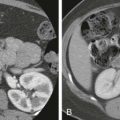Chapter Outline
This chapter discusses a variety of benign and malignant tumors of the colon as separate entities. Although these tumors are associated with a wide range of clinical and radiologic manifestations, they may have typical features on imaging studies that suggest the correct diagnosis.
Lymphoma
Pathologic Findings
Malignant lymphomas involve the gastrointestinal (GI) tract as primary neoplasms or as part of a disseminated disease. The colon is the third most common primary site of lymphoma involving the GI tract (after the stomach and small bowel); colonic involvement occurs in 6% to 12% of cases. Primary lymphoma of the colon is rare, comprising less than 1% of all primary malignant tumors of the colon. Colonic involvement by systemic lymphoma is relatively common, with microscopic evidence of tumor in up to 44% of cases at autopsy. Non-Hodgkin’s lymphoma accounts for almost all colonic lymphomas; Hodgkin’s lymphoma involving the colon is extremely rare. Primary colonic lymphoma is usually a B-cell lymphoma; diffuse large B-cell lymphoma is the most common primary colonic subtype.
Clinical Findings
Primary non-Hodgkin’s lymphoma involving the colon is usually seen in middle-aged or older persons. Men are more frequently affected than women by a ratio of 2 : 1. Abdominal pain, weight loss, and altered bowel habits occur in 60% to 90% of patients, and rectal bleeding or diarrhea occur in 25%. A palpable abdominal mass is the most frequent physical finding. Long-standing ulcerative colitis appears to be a predisposing condition, but the development of lymphoma in these patients may be related more to treatment with immunosuppressive agents than to the disease itself. Extranodal presentation of post-transplantation lymphoproliferative disorders is typical, and B-cell lymphomas may arise in the colon after solid organ transplantation. Anorectal lymphoma is seen in HIV-infected patients, but this has been decreasing in frequency.
Radiographic Findings and Differential Diagnosis
The primary form of colonic lymphoma usually involves the ileocecal valve, cecum, or rectum. In contrast, systemic lymphoma usually involves the entire colon or long segments of bowel. The primary localized form of colonic lymphoma may be manifested by a variety of radiographic findings, including a polypoid or cavitary mass or circumferential mural lesion.
Bulky polypoid masses represent the most common form of primary colonic lymphoma. These tumors usually appear as smooth-surfaced, broad-based sessile lesions, with or without central depressions or ulcerations. These lesions vary from 4 to 20 cm in size and are usually located near the ileocecal valve ( Fig. 60-1 ). Extension of cecal lymphoma into the terminal ileum is not uncommon (see Fig. 60-1 ).
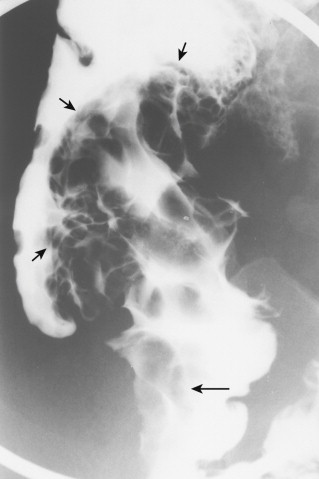
The annular infiltrating form of colonic lymphoma usually involves a long segment of colon, appearing as a concentric area of narrowing or as a cavitary mass ( Fig. 60-2 ). Although the colonic lumen may be narrowed, obstruction is uncommon. The infiltrating form is usually characterized by a discrete lesion, with thickened, irregular haustral folds and a nodular surface pattern. Although the contour is irregular, the mucosal surface is smooth, suggesting submucosal infiltration rather than mucosal ulceration. Thus, the major considerations in the differential diagnosis of the annular infiltrating form of lymphoma include submucosal hemorrhage and edema (caused by ischemia or a bleeding diathesis) and an unusual colonic carcinoma.
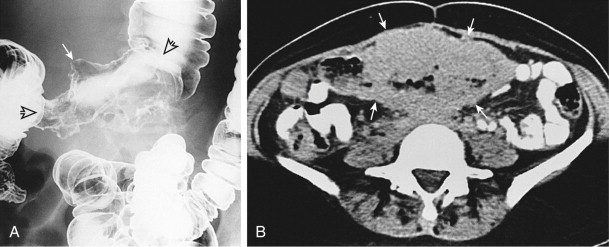
Large infiltrating tumors may extend into the mesentery or exhibit central cavitation, resulting in a bulky, cavitary mass lesion. The major considerations in the differential diagnosis of the cavitary form of lymphoma include a perforated colonic carcinoma and a mesenchymal tumor, such as a GI stromal tumor.
The diffuse multinodular form of colonic lymphoma (lymphomatous polyposis) is associated with disseminated disease from a nodal primary lymphoma or occurs as a true primary GI lymphoma. Histologically, this form of lymphoma is usually a mantle cell lymphoma derived from a subpopulation of mantle zone cells. These multinodular lymphomas involve long segments of the colon or the entire colon. The small intestine may be simultaneously involved. The tumors disseminate rapidly to the liver, spleen, peripheral lymph nodes, and bone marrow. More than 100 nonuniform, smooth, sessile nodules varying from 2 to 25 mm in size carpet the colonic surface. The nodules are occasionally elongated, pedunculated, umbilicated, or filiform. A conglomerate cecal mass is seen in almost 50% of cases. Associated mesenteric lymph nodes are usually enlarged. The multinodular form of colonic lymphoma may be confused radiographically with familial polyposis, lymphoid hyperplasia, inflammatory bowel disease, or infectious diseases, such as pseudomembranous colitis or schistosomiasis. The nodules of colonic lymphoma are nonuniform and relatively large in comparison to the uniform, 1- to 2-mm nodules of lymphoid hyperplasia. Unlike the pseudopolyposis in inflammatory bowel disease, the haustral pattern is also preserved in colonic lymphoma, and ulceration is uncommon. Conglomerate cecal masses are more frequent in disseminated lymphoma than in the polyposis syndromes. Rarely, diffuse colonic lymphoma may be associated with acute toxic dilation or pneumatosis coli.
Vascular Lesions
Hemangioma
Clinical and Pathologic Findings
Hemangiomas of the colon are rare vascular lesions, but the radiologic diagnosis is important because these lesions may be misdiagnosed at endoscopy and have a high mortality rate related to severe GI bleeding. Patients with colonic hemangiomas usually present at a young age with acute, recurrent, or chronic rectal bleeding. Some patients may have severe, life-threatening rectal bleeding ; mortality rates for this tumor approach 50%. Obstructive symptoms and diarrhea are uncommon, occurring in 15% to 20% of cases. Occasionally, patients with anorectal lesions may complain of tenesmus or constipation.
Cavernous hemangiomas are the most common form; capillary hemangiomas are second in frequency. Cavernous hemangiomas are unencapsulated lesions, usually arising in the submucosa. They are composed of large, multiloculated, thin-walled vessels separated by loose connective tissue. They usually occur in the rectum or sigmoid colon, appearing as discrete submucosal masses or, more frequently, as diffuse, infiltrative lesions. Polypoid tumors may intussuscept, causing obstruction, whereas infiltrative lesions often ulcerate and bleed.
Capillary hemangiomas usually occur as solitary, sharply circumscribed submucosal masses in asymptomatic patients. The tumors are composed of small vessels lined by well-differentiated endothelial cells. The vessels are packed together, with scant surrounding connective tissue. These tumors are occasionally associated with cutaneous or visceral hemangiomas. Colonic hemangiomas may occur in the Klippel-Trenaunay syndrome, manifested by the triad of cutaneous hemangiomas, soft tissue hypertrophy of the involved lower extremity, and congenital varicose veins. Cavernous hemangiomas of the colon are also seen in the blue rubber bleb nevus syndrome and in some patients with Peutz-Jeghers syndrome. Hemangiomas have also been reported in 5% to 8% of patients with Turner’s syndrome. Colonic hemangiomas have no propensity for malignant transformation and should therefore be distinguished from their true neoplastic counterpart, angiosarcomas.
Radiographic Findings and Differential Diagnosis
Rectal hemangiomas are frequently misdiagnosed on endoscopy as hemorrhoids or proctitis. As a result, the radiologist may be the first physician to suggest the correct diagnosis. Plain abdominal radiographs may show multiple phleboliths along the course of the bowel in 50% of cases. Hemangiomas should therefore be suspected if abdominal radiographs demonstrate phleboliths in young patients with GI bleeding or clusters of phleboliths in atypical locations or along the expected course of the rectosigmoid colon.
Barium enema examinations usually reveal a circumferential lesion, with scalloped contours and a nodular mucosal surface pattern. The colonic lumen is narrowed in 50% of cases. If the tumor is in its usual rectosigmoid location, a wide presacral space may be seen. If phleboliths are visible, they are seen in the expected location of the colonic tumor ( Fig. 60-3 ). The polypoid form of hemangioma is usually manifested by smooth, sessile, broad-based submucosal masses.
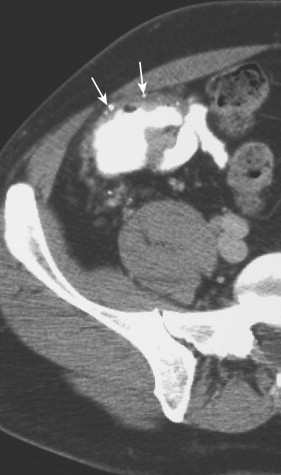
Although hemangiomas are usually vascular at angiography, they may occasionally be hypovascular or avascular because of vessel thrombosis and sclerosis. Computed tomography (CT) better delineates the true dimensions of the mass (see Fig. 60-3 ) and involvement of adjacent structures, such as the urinary bladder. Hemangioma is included in the differential diagnosis of polypoid submucosal masses, but the most common submucosal mass in the colon is a lipoma. Hemangioma is also included in the differential diagnosis of infiltrative submucosal rectosigmoid lesions, such as those found in solitary rectal ulcer syndrome or lymphoma. However, the clinical history and presence of phleboliths should suggest the correct diagnosis.
Lymphangioma
Lymphangiomas of the colon are extremely rare benign lesions of neoplastic or hamartomatous origin. The lesions are composed of a cluster of lymphatic spaces lined by endothelial cells and separated by connective tissue septa. These dilated lymphatics are usually found in the muscularis mucosae or submucosa. Some lymphangiomas arise in the colonic mesentery. Patients with colonic lymphangiomas usually present in the fourth to sixth decade of life with abdominal pain, rectal bleeding, watery diarrhea, and/or altered bowel habits. Lymphangiomas may appear radiographically as solitary, 2- to 4-cm, often pedunculated polypoid lesions or as smooth submucosal masses. These soft tumors are pliable, changing in size or shape with compression or varying luminal distention, and they may be compressible during endoscopic ultrasound. A cystic or multicystic mass is often found on endoscopic ultrasonography or CT. The smooth unilocular or multilocular submucosal mass is of water attenuation (0-20 HU) on CT.
Angiodysplasia
Clinical and Pathologic Findings
Angiodysplasia is a common cause of chronic low-grade or acute massive lower GI bleeding in older patients. These lesions are acquired vascular ectasias, possibly caused by chronic, low-grade colonic obstruction. Angiodysplasias are composed of clusters of dilated, tortuous, thin-walled veins, venules, and capillaries localized in the colonic mucosa and submucosa. The mucosal layer overlying the vascular tuft may be thin or ulcerated. These lesions are single or multiple and small (usually <5 mm), usually found in the cecum or ascending colon.
Angiodysplasias may coexist with other causes of GI bleeding. These lesions have been found at autopsy in 2% of asymptomatic older patients and, in one series, angiodysplasias were present in the resected specimens in 12 of 15 patients who had undergone surgery for colonic carcinoma. Angiodysplasias are not associated with angiomatous lesions of the skin or other viscera.
Radiographic Findings
Angiodysplasias may be detected during the work-up of patients with severe or recurrent lower GI bleeding after a normal barium enema or colonoscopy. During the arterial phase of angiography, a focus of angiodysplasia usually appears as a tangle of small vessels at the end of a cecal or right colonic artery. Early filling of draining veins with contrast medium is usually seen, but extravasation of contrast medium rarely occurs. The radiologist is critical to the diagnosis of angiodysplasia because the surgeon is unable to see or palpate these lesions during surgery. The pathognomonic histologic findings are not usually present on endoscopic biopsy specimens. As a result, the decision for surgery is made on the basis of the radiographic findings and the clinical history of severe or recurrent lower GI bleeding.
Kaposi’s Sarcoma
Kaposi’s sarcoma involving the colon usually occurs in patients with AIDS. Kaposi’s sarcoma has also been reported in HIV-negative patients with Crohn’s disease or ulcerative colitis and in patients who have undergone solid organ transplantation. Colonic Kaposi’s sarcoma is associated with human herpesvirus 8 infection. Kaposi’s sarcoma in the colon is manifested radiographically by a flat or plaquelike lesion, small polypoid nodule, or polypoid submucosa-appearing mass, with or without central umbilication. The tumor is usually confined to the mucosa and submucosa.
Endocrine (Carcinoid) Tumors
Pathologic Findings
Endocrine cells are scattered throughout the GI tract. These cells synthesize and secrete a variety of peptide hormones and biogenic amines. The endocrine cells give rise to GI tumors traditionally termed carcinoid tumors but now preferably termed endocrine cell tumors. The most common sites of endocrine cell tumors include the appendix (35%), ileum (16%), lung (14%), and rectum (13%). Endocrine cell tumors arising in the remainder of the colon constitute only 2% to 3% of all carcinoid tumors.
The most common sites of endocrine cell tumors in the colon are the rectum and cecum. Endocrine tumors involving the cecum and ascending or transverse colon are of midgut origin. These midgut lesions may synthesize, store, and secrete serotonin. Although serotonin may be produced, carcinoid syndrome is rare. If carcinoid syndrome is present, it is usually associated with liver metastases.
Hindgut endocrine cell tumors involve the descending colon, sigmoid colon, and rectum. They primarily synthesize and store a variety of polypeptide hormonal substances, including gastrin, somatostatin, glucagon, and vasoactive intestinal polypeptide. These tumors do not usually produce serotonin or cause carcinoid syndrome.
Endocrine Cell Tumors of the Rectum
Endocrine cell tumors arising in the rectum are usually small, smooth, submucosal polypoid lesions less than 2 cm in diameter and are located in the lower two thirds of the rectum. Most cases are discovered incidentally during a screening barium enema examination or endoscopy or during work-up for rectal pain or bleeding. Small rectal carcinoids have low malignant potential and are cured by simple and complete excision. As with any carcinoid tumor, the larger the tumor, the greater the chance of metastases at the time of diagnosis. Although rare, large rectal endocrine cell tumors are associated with a much greater frequency of metastases at the time of diagnosis. Large rectal carcinoids may appear as irregular ulcerated masses. If all rectal endocrine cell tumors are considered, patients with rectal carcinoids have an overall 5-year survival rate of about 85%.
Endocrine Tumors (Exclusive of the Rectum)
Endocrine cell tumors of the remainder of the colon have a very different clinical history, morphology, and prognosis than small low-grade endocrine tumors of the rectum. Endocrine cell tumors in the colon (exclusive of the rectum) are usually large aggressive lesions associated with a poor prognosis. Patients usually present in the sixth decade of life with symptoms similar to those of colonic adenocarcinoma, including abdominal pain, distention, and a palpable abdominal mass. Rectal bleeding and diarrhea are seen in approximately one third of patients.
Endocrine cell tumors of the colon are usually located in the cecum or ascending colon. These tumors appear on barium enemas as large (>5 cm), fungating intraluminal masses or as irregular annular lesions ( Fig. 60-4 ) that are indistinguishable from those of colonic carcinoma. In other patients, these endocrine cell tumors may appear as smooth, polypoid submucosal masses. At the time of diagnosis, 50% to 60% of patients with large endocrine tumors have metastases to the liver, lymph nodes, mesentery, or peritoneum. Overall, 5-year survival rates of approximately 50% have been reported.
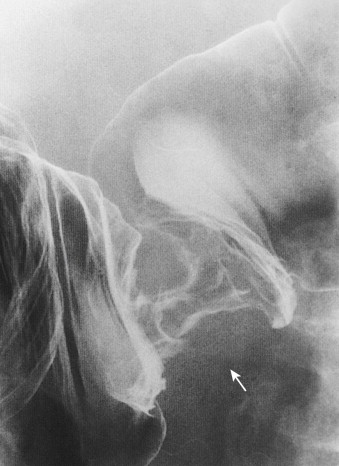
Fatty Lesions
Lipoma
Clinical Findings
Colonic lipomas are benign uncommon lesions, occurring at autopsy in less than 1% of patients. Colonic liposarcomas are exceedingly rare. However, the colon is the most frequent site of GI involvement by lipomas. Most patients are asymptomatic, and the tumors are detected during studies performed for symptoms ultimately attributed to other causes. When these patients are symptomatic, they usually present with abdominal pain and discomfort. Rectal bleeding and pain related to intussusception are less common.
Pathologic Findings
Most colonic lipomas are found in the right colon, and 90% originate in the submucosa. The remaining 10% arise in the appendices epiploicae. Multiple tumors are found in up to 25% of patients. Colonic lipomas are usually smaller than 3 cm in diameter, but those that cause symptoms tend to be larger lesions.
Colonic lipomas are encapsulated masses of mature adipose tissue usually confined to the submucosa. Approximately two thirds of these tumors are pedunculated, with a broad-based pedicle covered by normal colonic mucosa. Because of this pedunculation, local trauma and mechanical irritation may lead to focal ulceration and fat necrosis. Continuing inflammation may cause fibrosis and calcification.
Radiographic Findings
Colonic lipomas usually appear on barium enemas as smooth, sessile submucosal masses or as smooth polypoid lesions on a broad-based pedicle ( Fig. 60-5 ). Lipomas may be round, ovoid, or pear-shaped. They are sharply demarcated masses that form obtuse angles with the adjacent colonic wall. Although these lesions may have a lobulated contour, the mucosal surface is smooth (see Fig. 60-5 ). Because of the pliable nature of fat, lipomas change shape with palpation, position of the patient, or varying degrees of colonic distention. These tumors may also elongate during colonic spasm or after colonic evacuation. Some lipomas may serve as the lead point for colocolic intussusceptions.
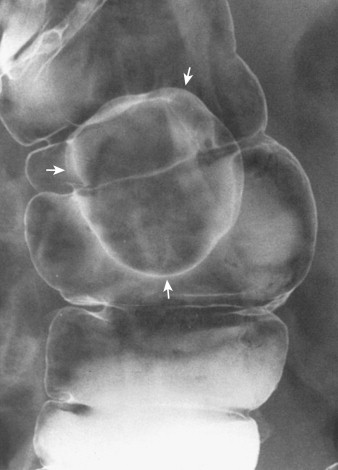
Before the advent of CT, the barium enema was considered to be a relatively accurate test for the diagnosis of colonic lipoma. However, a definitive diagnosis of a colonic lipoma can be made on CT when it shows a mass of uniform fat density (60-120 HU) without septa or other large areas of nonfatty tissue ( Fig. 60-6 ).
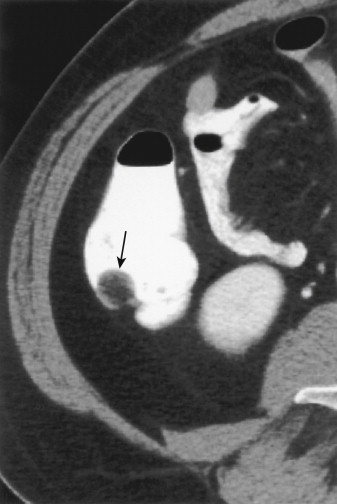
When colonic lipomas intussuscept, they can ulcerate and undergo fat necrosis, resulting in CT attenuation numbers higher than those of fat. As a result, an intussuscepting lipoma appearing as a soft tissue mass or having only a small focus of fat attenuation may be confused with an intussuscepting carcinoma. The radiologist can also confuse any intussuscepting tumor with a lipoma if the eccentrically invaginating mesenteric fat associated with the intussuscepting tumor mass is mistaken for the fat of a lipoma. Lipomas can also be diagnosed via endoscopic ultrasound as smooth hemispheric polyps with a broad base containing hyperechoic tissue or tissue of intermediate echogenicity.
Fat ty Infiltration of the Ileocecal Valve
Pathologic, Clinical, and Radiographic Findings
Fatty infiltration (also known as lipohyperplasia or lipomatous infiltration) of the ileocecal valve results from a localized massive accumulation of submucosal fat in this region. The lack of a capsule differentiates this fatty proliferation pathologically from a true lipoma. Fatty infiltration of the ileocecal valve is associated with obesity. The diagnosis is suggested on barium enema when there is a large ileocecal valve with smooth or lobulated contours and a smooth mucosal surface without a discrete polypoid mass. Although rigid measurements are not reliable in distinguishing a normal-sized ileocecal valve from an enlarged valve, some investigators have suggested that a normal ileocecal valve should be 4 cm or less. Others have found that one lip of a normal valve should be 1.5 cm or less. A normal ileocecal valve may also have stellate folds radiating toward its center.
Differential Diagnosis
The radiologist must first decide whether the polypoid projection in the cecum arises on or near the ileocecal valve or actually represents the valve. The normal ileocecal valve is usually located at the level of the first complete haustral fold on the medial or posterior colonic wall at the junction of the cecum and ascending colon. Filling of the terminal ileum with barium confirms the location of the ileocecal valve. If an ileocecal valve is mildly enlarged (>4 cm) and has a smooth or slightly lobulated contour and smooth mucosal surface, the most likely diagnosis is fatty infiltration of the valve ( Fig. 60-7 ). In contrast, a focal polypoid projection from the ileocecal valve may represent a tumor, such as an adenoma or lipoma ( Fig. 60-8 ). Any mucosal surface irregularity of the ileocecal valve should also suggest the possibility of tumor involving the valve, including an adenocarcinoma. The ileocecal valve may also be involved by Crohn’s disease or lymphoma. In Crohn’s disease, there is fatty hypertrophy of the valve, usually associated with other radiographic findings of Crohn’s disease in the terminal ileum and ileocecal fistulas. In lymphoma, the ileocecal valve is moderately enlarged and has a lobulated contour, usually because of the spread of lymphoma from the terminal ileum.
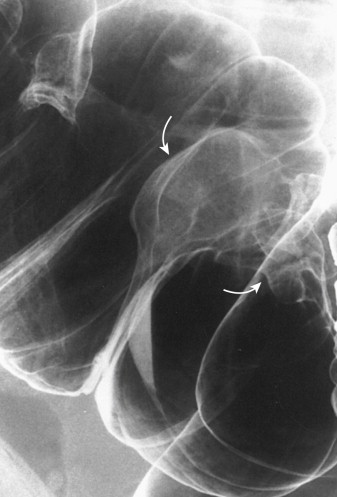
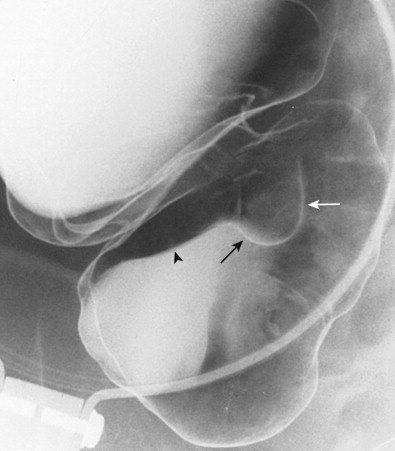
Stay updated, free articles. Join our Telegram channel

Full access? Get Clinical Tree





